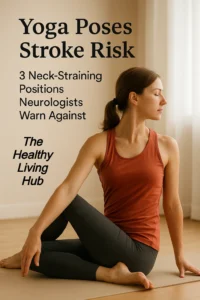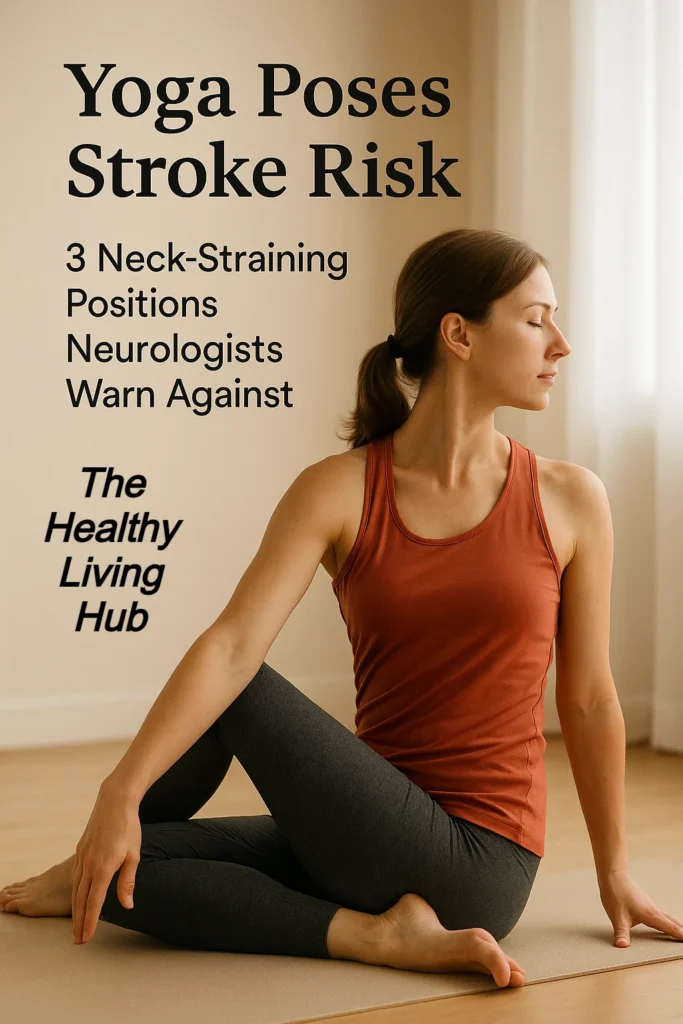Yoga is widely loved for its calming effects, improved flexibility, and deep sense of well-being. But few people talk about a lesser-known issue: Yoga Poses Stroke Risk.
While extremely rare, some neck-straining yoga positions can affect blood flow to the brain, potentially leading to serious complications in vulnerable individuals. Understanding these risks — and learning how to practice more safely — can help you enjoy yoga without fear.

🧠 How Certain Yoga Poses Can Impact Your Brain and Neck
Your neck houses two major arteries — the vertebral and carotid — which supply blood to the brain. In rare cases, extreme neck movements or prolonged pressure in certain positions can irritate or damage these vessels.
Neurologists explain that sudden or forceful neck extension can temporarily affect blood circulation, and in extremely rare cases, may contribute to arterial injury. This is not something most people need to fear, but it’s important to be aware — especially for beginners or people with underlying vascular issues.
⚠️ 3 Yoga Poses That Could Increase Stroke Risk
While yoga is generally safe when practiced mindfully, certain advanced postures put significant pressure on the neck. These are the three positions experts most commonly caution against for people with neck sensitivity or vascular conditions.
1. Shoulder Stand (Sarvangasana)
The shoulder stand is known for its calming and restorative effects, but it also places your entire body weight on the neck and shoulders. When done incorrectly, this can compress blood vessels and reduce normal blood flow.
Why it matters:
Sudden pressure or improper alignment may strain delicate neck tissues.
Beginners often over-stretch the cervical spine.
People with neck pain, hypertension, or clotting disorders should be especially careful.
👉 If you love this pose, use props like folded blankets under the shoulders and avoid holding it for too long.
2. Headstand (Sirsasana)
The headstand is a powerful inversion that flips the world upside down — and it demands perfect alignment. When practiced without proper technique or strength, it can create intense pressure on the neck.
Expert insight:
Neurologists warn that unsupported or jerky entry into headstand may irritate blood vessels in the upper spine. In rare situations, this can trigger symptoms like dizziness, sudden headaches, or vision changes.
Safer alternative: Try Dolphin Pose, which builds shoulder and core strength without compressing the neck.
3. Deep Neck Twists and Extreme Rotations
Some gentle twists are healthy for the spine. But very deep or rapid neck rotations, especially when combined with breath-holding or sudden movements, can increase the risk of arterial strain.
Examples include:
Forcibly looking over one shoulder while seated.
Aggressive twisting during warm-ups.
Quick neck rolls performed repeatedly.
Experts emphasize that controlled movement and gradual flexibility are key. Never push beyond what feels natural.
🧘♂️ What Neurologists Say About Yoga and Stroke Risk
The phrase Yoga Poses Stroke Risk can sound alarming — but experts are quick to point out that strokes triggered by yoga are extremely rare. Most healthy individuals face no danger when practicing correctly.
Paraphrased neurologist advice:
“The issue is not yoga itself, but incorrect technique and ignoring warning signs. When the neck is strained suddenly or held in extreme positions without support, sensitive blood vessels may be affected.”
If you experience warning signs like sudden headache, blurred vision, slurred speech, numbness, or dizziness during or after a pose, stop immediately and seek medical attention.
🪷 How to Practice Yoga Safely (Expert Tips)
You don’t need to abandon challenging poses — just approach them intelligently. Here are expert-backed tips to lower your risk:
✅ Warm up gently before inversions or twists.
🪄 Build strength slowly in the neck, shoulders, and core.
🧍♀️ Use props and modifications instead of forcing full expressions of poses.
🧘 Avoid jerky or rushed movements when entering or exiting poses.
💬 Listen to your body — mild stretching is fine; pain or lightheadedness is not.
📅 Consult your doctor if you have vascular issues, blood pressure problems, or prior neck injuries.
👉 You can explore more gentle yoga options here:
Yoga for PCOS & PCOD: 6 Gentle Poses to Naturally Restore Hormonal Health 🧘♀️
🏥 When to Seek Medical Help
If you ever experience symptoms like:
Sudden, severe headache
Weakness on one side of the body
Trouble speaking
Vision changes
Dizziness or loss of balance
👉 Call emergency services right away. These may be signs of a stroke or vascular issue, and immediate medical attention can save lives.
🌿 Final Thoughts: Balance Mindfulness With Safety
Yoga is meant to heal, not harm. Understanding the Yoga Poses Stroke Risk doesn’t mean you should fear your practice — it simply helps you make smarter choices.
With mindful alignment, gradual progression, and attention to your body’s limits, you can continue to enjoy yoga’s incredible physical and mental benefits for years to come.
For more holistic lifestyle guidance, check out:
👉 Diet for Colorectal Cancer Prevention: Carrots and Sweet Potatoes Cut Risk by 40%

